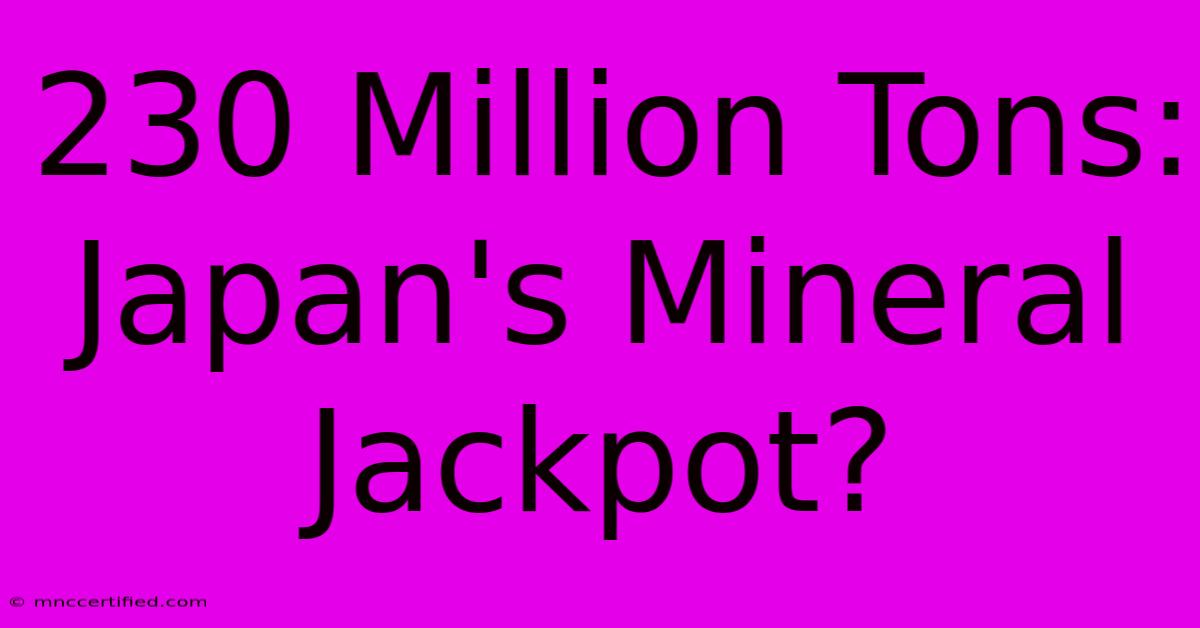230 Million Tons: Japan's Mineral Jackpot?

Table of Contents
230 Million Tons: Japan's Mineral Jackpot? Unlocking a Future of Resource Security
Japan, a nation renowned for its technological prowess and economic strength, faces a critical challenge: resource scarcity. Heavily reliant on imports for essential minerals, the country's vulnerability to global supply chain disruptions and geopolitical instability is a pressing concern. However, a recent discovery could significantly alter this landscape: an estimated 230 million tons of rare earth elements (REEs) and other crucial minerals potentially residing beneath the seabed surrounding Japan. This discovery presents both a monumental opportunity and a significant undertaking. This article delves into the potential implications of this "mineral jackpot," examining the challenges and rewards involved in its exploitation.
The Significance of Rare Earth Elements
Before exploring the specifics of Japan's potential resource boom, it's crucial to understand the importance of rare earth elements. These 17 elements, including neodymium, dysprosium, and terbium, are not actually rare in terms of overall abundance, but their extraction and processing are complex and often environmentally challenging. REEs are indispensable components in countless modern technologies:
- Green technologies: Wind turbines, electric vehicles, and solar panels all rely heavily on REEs for their functionality.
- Electronics: Smartphones, computers, and other electronics incorporate REEs in their magnets, screens, and other components.
- Military applications: REEs are crucial for advanced weaponry and defense systems.
Japan's current reliance on imported REEs leaves it vulnerable to price fluctuations and supply chain disruptions. The potential domestic source could drastically improve its resource security and bolster its economic competitiveness.
The 230 Million Ton Discovery: Potential and Challenges
The estimated 230 million tons of REEs and associated minerals are believed to lie within seabed massive sulfide (SMS) deposits. These deposits form near hydrothermal vents, where superheated, mineral-rich water interacts with cold seawater. While the potential is immense, several challenges stand in the way of exploiting this resource:
- Technological hurdles: Deep-sea mining presents significant technological challenges. The immense water pressure, extreme depths, and the need for environmentally responsible extraction methods require substantial investment in research and development.
- Environmental concerns: Deep-sea mining carries potential environmental risks, including damage to delicate ecosystems, habitat destruction, and potential pollution from mining operations. Sustainable and environmentally conscious mining practices are paramount.
- Economic feasibility: The costs associated with deep-sea mining are substantial, including exploration, extraction, and processing. A comprehensive cost-benefit analysis is crucial to determine the economic viability of this venture.
- Regulatory framework: Developing a robust and effective regulatory framework is essential to ensure responsible and sustainable mining practices while protecting the marine environment. International cooperation will be key in establishing global standards.
A Path Forward: Balancing Opportunity and Responsibility
Japan's potential mineral wealth presents a unique opportunity to enhance its energy security, strengthen its economy, and reduce its dependence on foreign imports. However, realizing this potential requires a careful and responsible approach. This involves:
- Investing in research and development: Significant investment in technology is needed to overcome the technological challenges associated with deep-sea mining.
- Prioritizing environmental sustainability: Developing and implementing environmentally responsible mining practices is crucial to minimize the ecological impact. This includes rigorous environmental impact assessments and the development of innovative, low-impact extraction technologies.
- Fostering international collaboration: Collaboration with other nations and international organizations is vital to share best practices and establish global standards for deep-sea mining.
- Transparency and public engagement: Open and transparent communication with the public is vital to build trust and ensure public support for the project.
The 230 million tons of minerals represent a significant potential windfall for Japan, but responsible development is paramount. Balancing economic opportunity with environmental stewardship will be crucial in determining whether this mineral jackpot truly delivers on its promise of a more secure and prosperous future. The path forward requires careful planning, technological innovation, and a steadfast commitment to sustainability. Only then can Japan harness this potential while safeguarding its precious marine environment.

Thank you for visiting our website wich cover about 230 Million Tons: Japan's Mineral Jackpot?. We hope the information provided has been useful to you. Feel free to contact us if you have any questions or need further assistance. See you next time and dont miss to bookmark.
Featured Posts
-
2024 25 Nations League Draw Details
Nov 19, 2024
-
Csa Travel Insurance Phone Number
Nov 19, 2024
-
Lee Carsley Reveals Tuchel Meeting Details
Nov 19, 2024
-
Sidemen 2025 Tickets Availability Check
Nov 19, 2024
-
Major Gmail Update For Users
Nov 19, 2024